Analysis of Social Media and Digital Marketing in Hospitality
VerifiedAdded on 2022/05/26
|142
|37253
|113
Project
AI Summary
This project delves into the utilization of social media and digital marketing within the hospitality sector, focusing on hotels and restaurants. It examines the impact of online communities, particularly on Facebook, and investigates how participation benefits (functional, hedonic, monetary, and social-psychological) influence community engagement. The research explores the relationships between community participation, brand trust, and brand commitment, considering demographic factors like age and gender as potential moderators. The study employs Structural Equation Modeling (SEM) to analyze data from both hotel and restaurant Facebook fan pages, revealing distinct findings for each. Key outcomes include the identification of benefit factors driving participation, the positive influence of participation on brand trust and commitment, and the moderating effects of demographic variables. The project offers valuable insights for marketers and researchers, providing empirical evidence of consumer behavior in social media and suggesting strategies to enhance online community engagement and brand relationships within the hospitality industry. The study concludes with a discussion of limitations and avenues for future research.
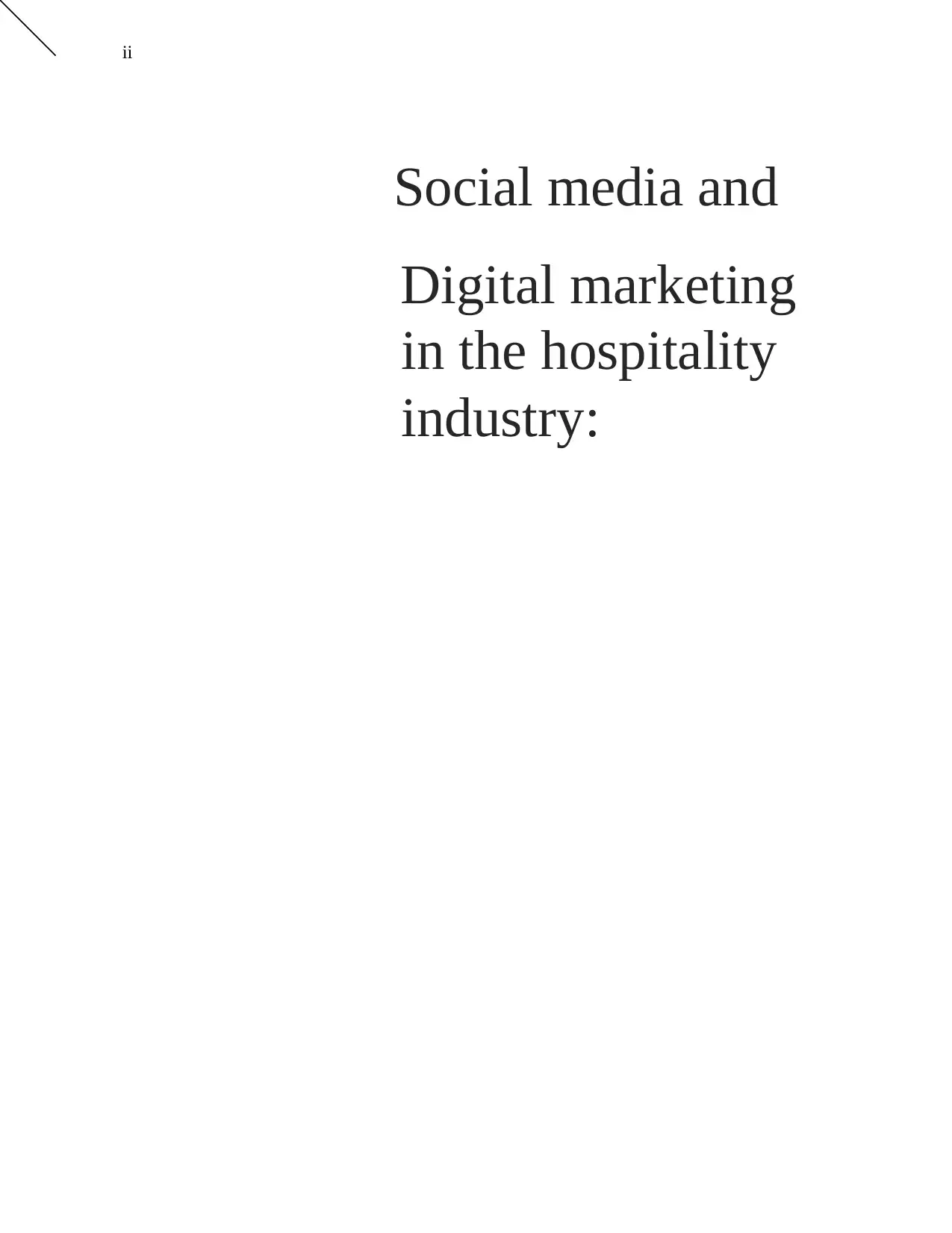
ii
Social media and
Digital marketing
in the hospitality
industry:
Social media and
Digital marketing
in the hospitality
industry:
Paraphrase This Document
Need a fresh take? Get an instant paraphrase of this document with our AI Paraphraser
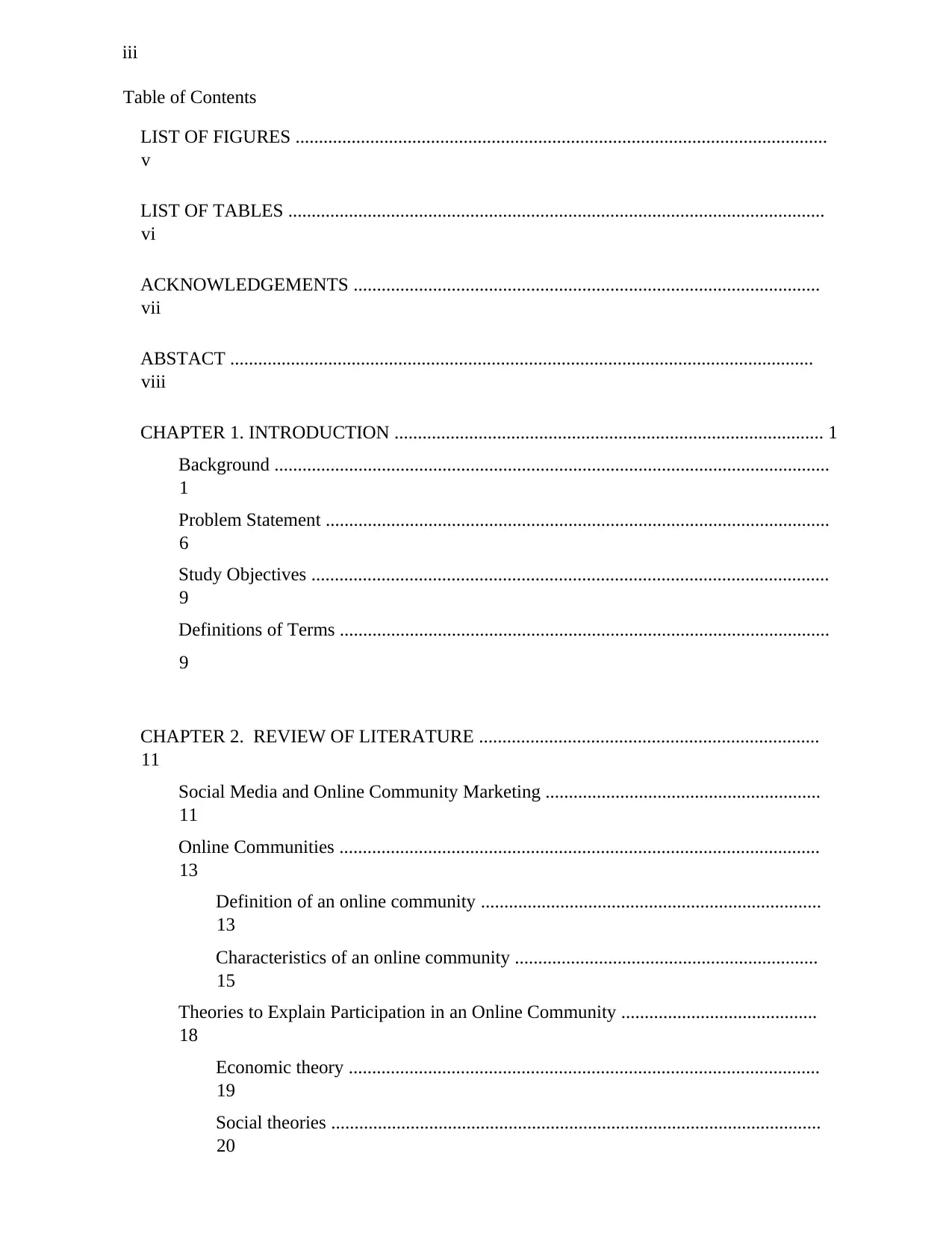
iii
Table of Contents
LIST OF FIGURES ..................................................................................................................
v
LIST OF TABLES ...................................................................................................................
vi
ACKNOWLEDGEMENTS ....................................................................................................
vii
ABSTACT .............................................................................................................................
viii
CHAPTER 1. INTRODUCTION ............................................................................................ 1
Background .......................................................................................................................
1
Problem Statement ............................................................................................................
6
Study Objectives ...............................................................................................................
9
Definitions of Terms .........................................................................................................
9
CHAPTER 2. REVIEW OF LITERATURE .........................................................................
11
Social Media and Online Community Marketing ...........................................................
11
Online Communities .......................................................................................................
13
Definition of an online community .........................................................................
13
Characteristics of an online community .................................................................
15
Theories to Explain Participation in an Online Community ..........................................
18
Economic theory .....................................................................................................
19
Social theories .........................................................................................................
20
Table of Contents
LIST OF FIGURES ..................................................................................................................
v
LIST OF TABLES ...................................................................................................................
vi
ACKNOWLEDGEMENTS ....................................................................................................
vii
ABSTACT .............................................................................................................................
viii
CHAPTER 1. INTRODUCTION ............................................................................................ 1
Background .......................................................................................................................
1
Problem Statement ............................................................................................................
6
Study Objectives ...............................................................................................................
9
Definitions of Terms .........................................................................................................
9
CHAPTER 2. REVIEW OF LITERATURE .........................................................................
11
Social Media and Online Community Marketing ...........................................................
11
Online Communities .......................................................................................................
13
Definition of an online community .........................................................................
13
Characteristics of an online community .................................................................
15
Theories to Explain Participation in an Online Community ..........................................
18
Economic theory .....................................................................................................
19
Social theories .........................................................................................................
20
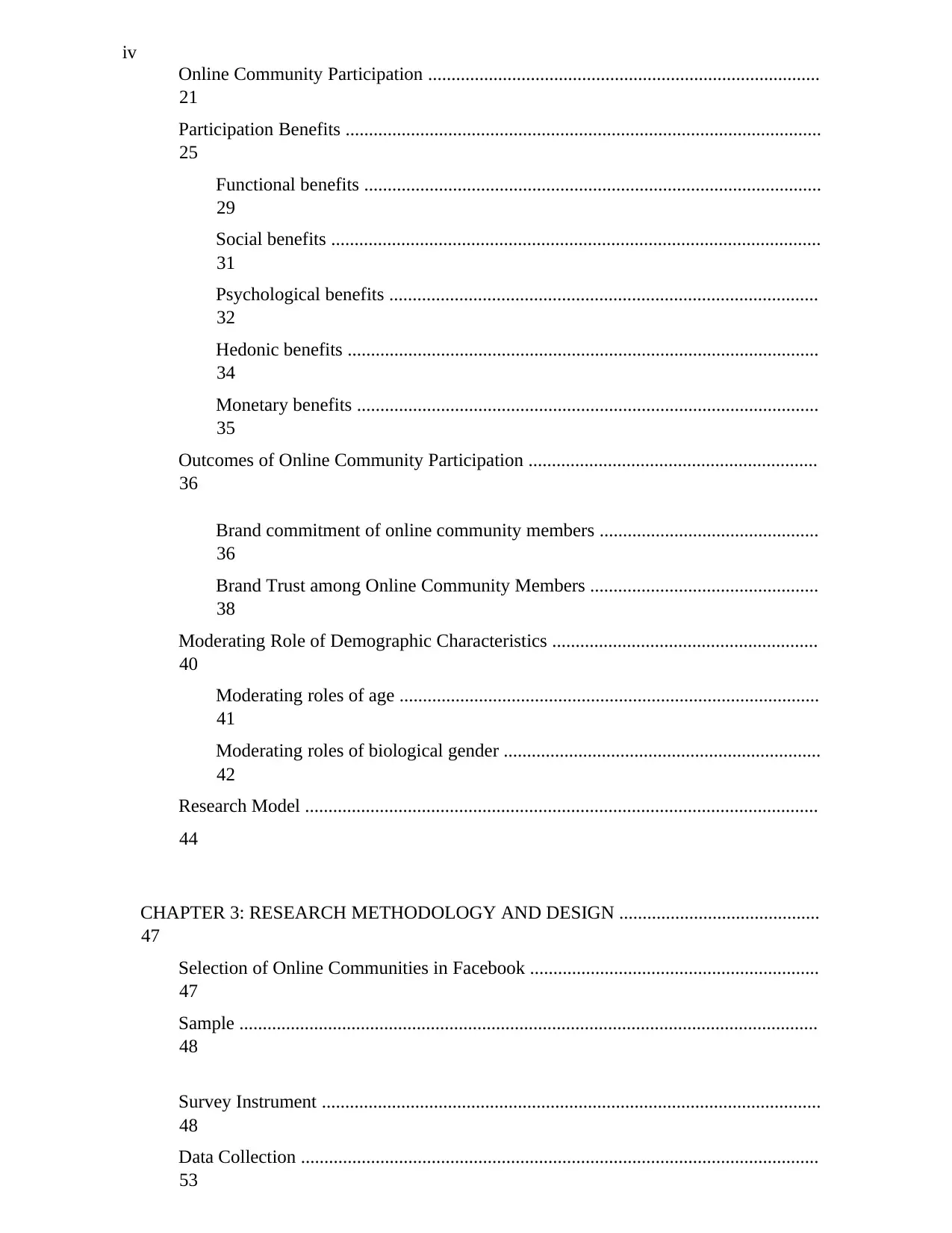
iv
Online Community Participation ....................................................................................
21
Participation Benefits ......................................................................................................
25
Functional benefits ..................................................................................................
29
Social benefits .........................................................................................................
31
Psychological benefits ............................................................................................
32
Hedonic benefits .....................................................................................................
34
Monetary benefits ...................................................................................................
35
Outcomes of Online Community Participation ..............................................................
36
Brand commitment of online community members ...............................................
36
Brand Trust among Online Community Members .................................................
38
Moderating Role of Demographic Characteristics .........................................................
40
Moderating roles of age ..........................................................................................
41
Moderating roles of biological gender ....................................................................
42
Research Model ..............................................................................................................
44
CHAPTER 3: RESEARCH METHODOLOGY AND DESIGN ...........................................
47
Selection of Online Communities in Facebook ..............................................................
47
Sample ............................................................................................................................
48
Survey Instrument ...........................................................................................................
48
Data Collection ...............................................................................................................
53
Online Community Participation ....................................................................................
21
Participation Benefits ......................................................................................................
25
Functional benefits ..................................................................................................
29
Social benefits .........................................................................................................
31
Psychological benefits ............................................................................................
32
Hedonic benefits .....................................................................................................
34
Monetary benefits ...................................................................................................
35
Outcomes of Online Community Participation ..............................................................
36
Brand commitment of online community members ...............................................
36
Brand Trust among Online Community Members .................................................
38
Moderating Role of Demographic Characteristics .........................................................
40
Moderating roles of age ..........................................................................................
41
Moderating roles of biological gender ....................................................................
42
Research Model ..............................................................................................................
44
CHAPTER 3: RESEARCH METHODOLOGY AND DESIGN ...........................................
47
Selection of Online Communities in Facebook ..............................................................
47
Sample ............................................................................................................................
48
Survey Instrument ...........................................................................................................
48
Data Collection ...............................................................................................................
53
⊘ This is a preview!⊘
Do you want full access?
Subscribe today to unlock all pages.

Trusted by 1+ million students worldwide
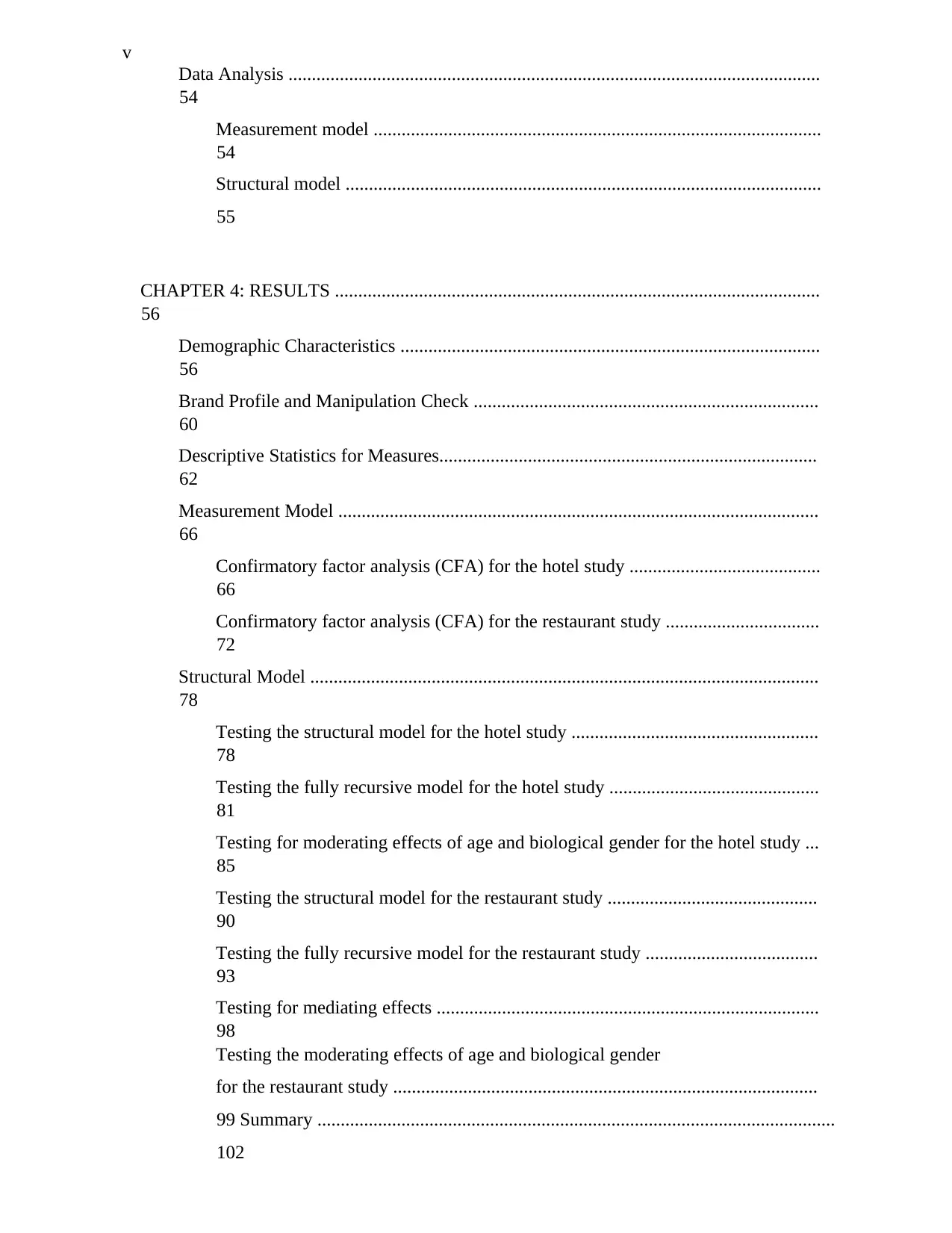
v
Data Analysis ..................................................................................................................
54
Measurement model ................................................................................................
54
Structural model ......................................................................................................
55
CHAPTER 4: RESULTS ........................................................................................................
56
Demographic Characteristics ..........................................................................................
56
Brand Profile and Manipulation Check ..........................................................................
60
Descriptive Statistics for Measures.................................................................................
62
Measurement Model .......................................................................................................
66
Confirmatory factor analysis (CFA) for the hotel study .........................................
66
Confirmatory factor analysis (CFA) for the restaurant study .................................
72
Structural Model .............................................................................................................
78
Testing the structural model for the hotel study .....................................................
78
Testing the fully recursive model for the hotel study .............................................
81
Testing for moderating effects of age and biological gender for the hotel study ...
85
Testing the structural model for the restaurant study .............................................
90
Testing the fully recursive model for the restaurant study .....................................
93
Testing for mediating effects ..................................................................................
98
Testing the moderating effects of age and biological gender
for the restaurant study ...........................................................................................
99 Summary ...............................................................................................................
102
Data Analysis ..................................................................................................................
54
Measurement model ................................................................................................
54
Structural model ......................................................................................................
55
CHAPTER 4: RESULTS ........................................................................................................
56
Demographic Characteristics ..........................................................................................
56
Brand Profile and Manipulation Check ..........................................................................
60
Descriptive Statistics for Measures.................................................................................
62
Measurement Model .......................................................................................................
66
Confirmatory factor analysis (CFA) for the hotel study .........................................
66
Confirmatory factor analysis (CFA) for the restaurant study .................................
72
Structural Model .............................................................................................................
78
Testing the structural model for the hotel study .....................................................
78
Testing the fully recursive model for the hotel study .............................................
81
Testing for moderating effects of age and biological gender for the hotel study ...
85
Testing the structural model for the restaurant study .............................................
90
Testing the fully recursive model for the restaurant study .....................................
93
Testing for mediating effects ..................................................................................
98
Testing the moderating effects of age and biological gender
for the restaurant study ...........................................................................................
99 Summary ...............................................................................................................
102
Paraphrase This Document
Need a fresh take? Get an instant paraphrase of this document with our AI Paraphraser
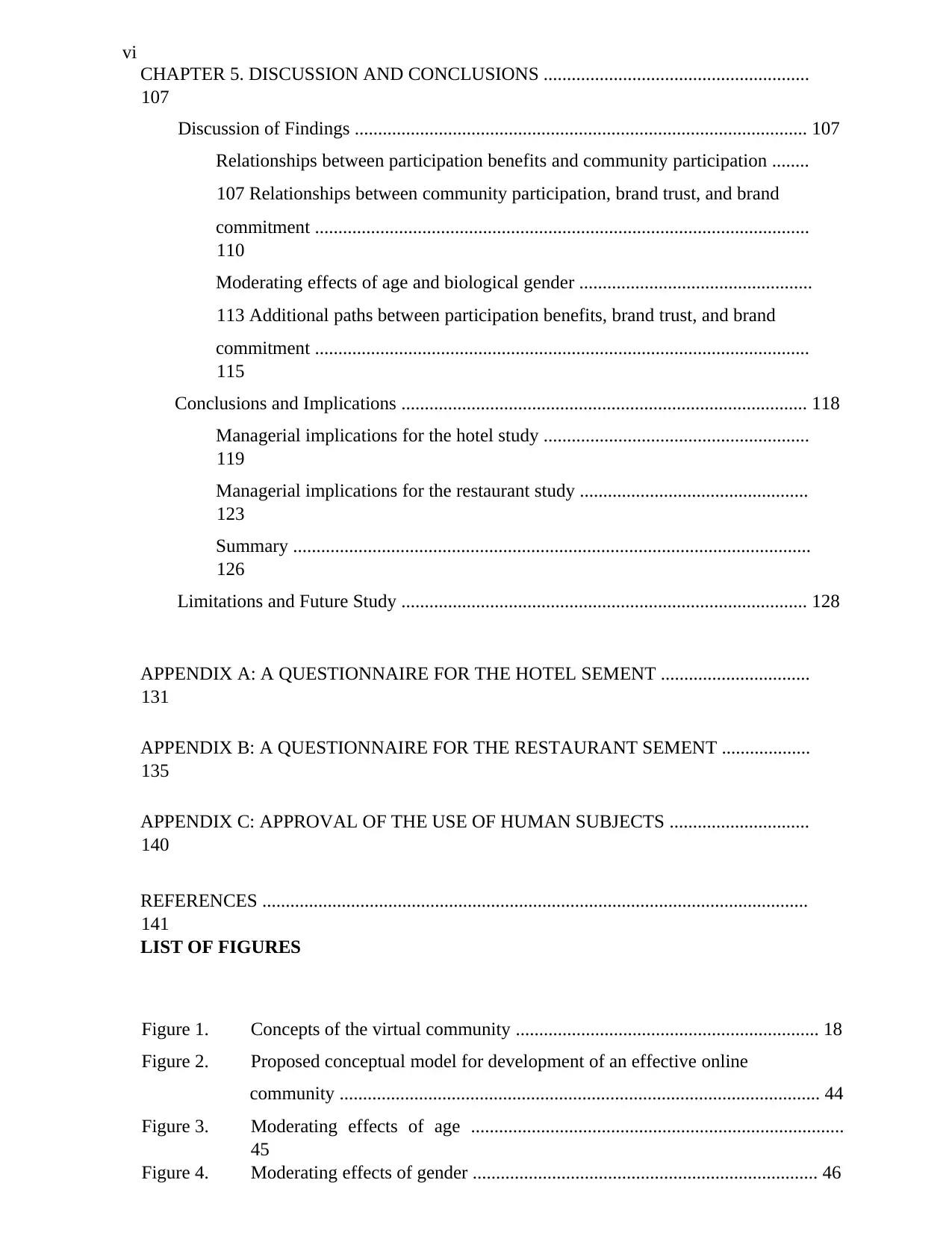
vi
CHAPTER 5. DISCUSSION AND CONCLUSIONS .........................................................
107
Discussion of Findings ................................................................................................. 107
Relationships between participation benefits and community participation ........
107 Relationships between community participation, brand trust, and brand
commitment ..........................................................................................................
110
Moderating effects of age and biological gender ..................................................
113 Additional paths between participation benefits, brand trust, and brand
commitment ..........................................................................................................
115
Conclusions and Implications ....................................................................................... 118
Managerial implications for the hotel study .........................................................
119
Managerial implications for the restaurant study .................................................
123
Summary ...............................................................................................................
126
Limitations and Future Study ....................................................................................... 128
APPENDIX A: A QUESTIONNAIRE FOR THE HOTEL SEMENT ................................
131
APPENDIX B: A QUESTIONNAIRE FOR THE RESTAURANT SEMENT ...................
135
APPENDIX C: APPROVAL OF THE USE OF HUMAN SUBJECTS ..............................
140
REFERENCES .....................................................................................................................
141
LIST OF FIGURES
Figure 1. Concepts of the virtual community ................................................................. 18
Figure 2. Proposed conceptual model for development of an effective online
community ....................................................................................................... 44
Figure 3. Moderating effects of age ................................................................................
45
Figure 4. Moderating effects of gender .......................................................................... 46
CHAPTER 5. DISCUSSION AND CONCLUSIONS .........................................................
107
Discussion of Findings ................................................................................................. 107
Relationships between participation benefits and community participation ........
107 Relationships between community participation, brand trust, and brand
commitment ..........................................................................................................
110
Moderating effects of age and biological gender ..................................................
113 Additional paths between participation benefits, brand trust, and brand
commitment ..........................................................................................................
115
Conclusions and Implications ....................................................................................... 118
Managerial implications for the hotel study .........................................................
119
Managerial implications for the restaurant study .................................................
123
Summary ...............................................................................................................
126
Limitations and Future Study ....................................................................................... 128
APPENDIX A: A QUESTIONNAIRE FOR THE HOTEL SEMENT ................................
131
APPENDIX B: A QUESTIONNAIRE FOR THE RESTAURANT SEMENT ...................
135
APPENDIX C: APPROVAL OF THE USE OF HUMAN SUBJECTS ..............................
140
REFERENCES .....................................................................................................................
141
LIST OF FIGURES
Figure 1. Concepts of the virtual community ................................................................. 18
Figure 2. Proposed conceptual model for development of an effective online
community ....................................................................................................... 44
Figure 3. Moderating effects of age ................................................................................
45
Figure 4. Moderating effects of gender .......................................................................... 46
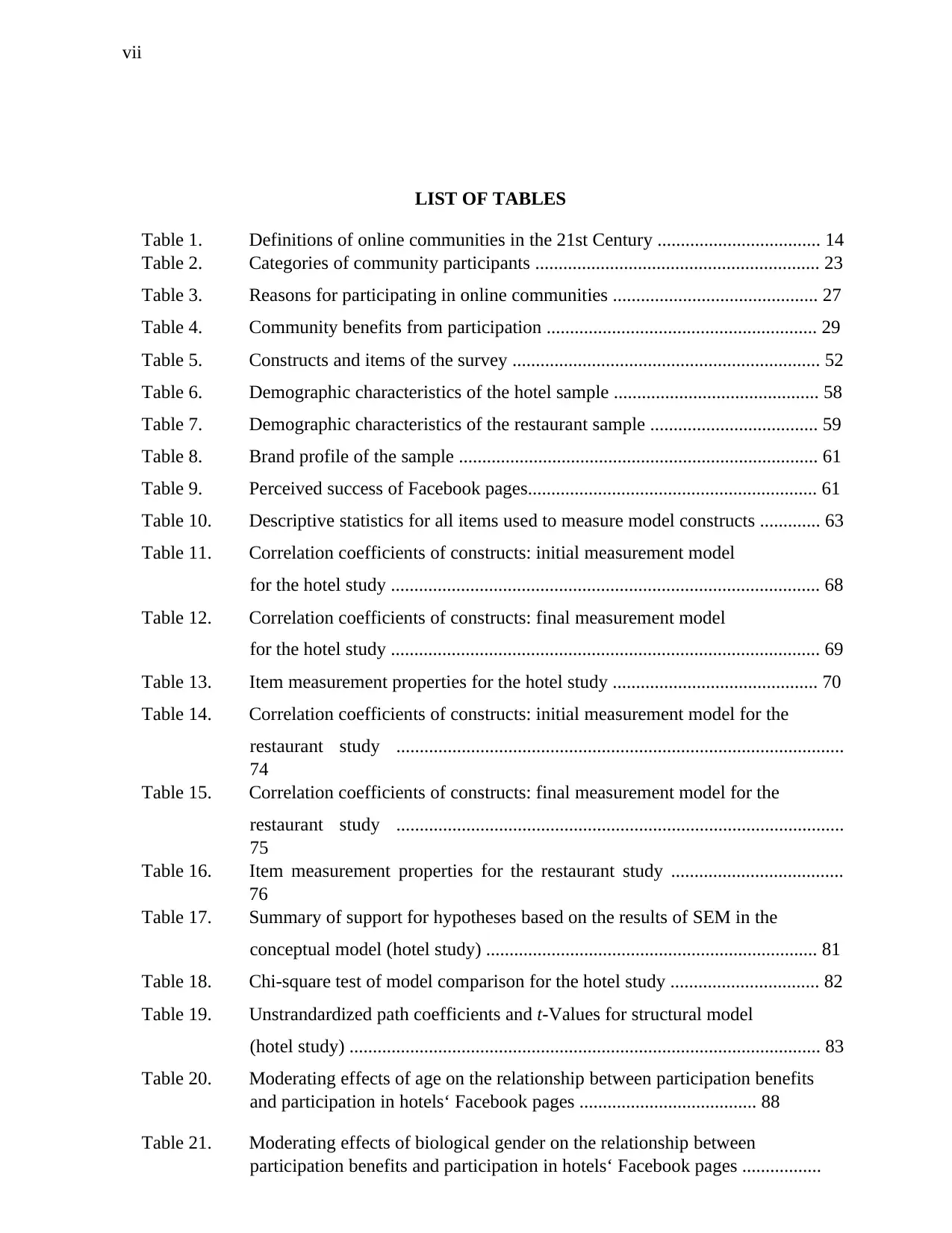
vii
LIST OF TABLES
Table 1. Definitions of online communities in the 21st Century ................................... 14
Table 2. Categories of community participants ............................................................. 23
Table 3. Reasons for participating in online communities ............................................ 27
Table 4. Community benefits from participation .......................................................... 29
Table 5. Constructs and items of the survey .................................................................. 52
Table 6. Demographic characteristics of the hotel sample ............................................ 58
Table 7. Demographic characteristics of the restaurant sample .................................... 59
Table 8. Brand profile of the sample ............................................................................. 61
Table 9. Perceived success of Facebook pages.............................................................. 61
Table 10. Descriptive statistics for all items used to measure model constructs ............. 63
Table 11. Correlation coefficients of constructs: initial measurement model
for the hotel study ............................................................................................ 68
Table 12. Correlation coefficients of constructs: final measurement model
for the hotel study ............................................................................................ 69
Table 13. Item measurement properties for the hotel study ............................................ 70
Table 14. Correlation coefficients of constructs: initial measurement model for the
restaurant study ................................................................................................
74
Table 15. Correlation coefficients of constructs: final measurement model for the
restaurant study ................................................................................................
75
Table 16. Item measurement properties for the restaurant study .....................................
76
Table 17. Summary of support for hypotheses based on the results of SEM in the
conceptual model (hotel study) ....................................................................... 81
Table 18. Chi-square test of model comparison for the hotel study ................................ 82
Table 19. Unstrandardized path coefficients and t-Values for structural model
(hotel study) ..................................................................................................... 83
Table 20. Moderating effects of age on the relationship between participation benefits
and participation in hotels‘ Facebook pages ...................................... 88
Table 21. Moderating effects of biological gender on the relationship between
participation benefits and participation in hotels‘ Facebook pages .................
LIST OF TABLES
Table 1. Definitions of online communities in the 21st Century ................................... 14
Table 2. Categories of community participants ............................................................. 23
Table 3. Reasons for participating in online communities ............................................ 27
Table 4. Community benefits from participation .......................................................... 29
Table 5. Constructs and items of the survey .................................................................. 52
Table 6. Demographic characteristics of the hotel sample ............................................ 58
Table 7. Demographic characteristics of the restaurant sample .................................... 59
Table 8. Brand profile of the sample ............................................................................. 61
Table 9. Perceived success of Facebook pages.............................................................. 61
Table 10. Descriptive statistics for all items used to measure model constructs ............. 63
Table 11. Correlation coefficients of constructs: initial measurement model
for the hotel study ............................................................................................ 68
Table 12. Correlation coefficients of constructs: final measurement model
for the hotel study ............................................................................................ 69
Table 13. Item measurement properties for the hotel study ............................................ 70
Table 14. Correlation coefficients of constructs: initial measurement model for the
restaurant study ................................................................................................
74
Table 15. Correlation coefficients of constructs: final measurement model for the
restaurant study ................................................................................................
75
Table 16. Item measurement properties for the restaurant study .....................................
76
Table 17. Summary of support for hypotheses based on the results of SEM in the
conceptual model (hotel study) ....................................................................... 81
Table 18. Chi-square test of model comparison for the hotel study ................................ 82
Table 19. Unstrandardized path coefficients and t-Values for structural model
(hotel study) ..................................................................................................... 83
Table 20. Moderating effects of age on the relationship between participation benefits
and participation in hotels‘ Facebook pages ...................................... 88
Table 21. Moderating effects of biological gender on the relationship between
participation benefits and participation in hotels‘ Facebook pages .................
⊘ This is a preview!⊘
Do you want full access?
Subscribe today to unlock all pages.

Trusted by 1+ million students worldwide
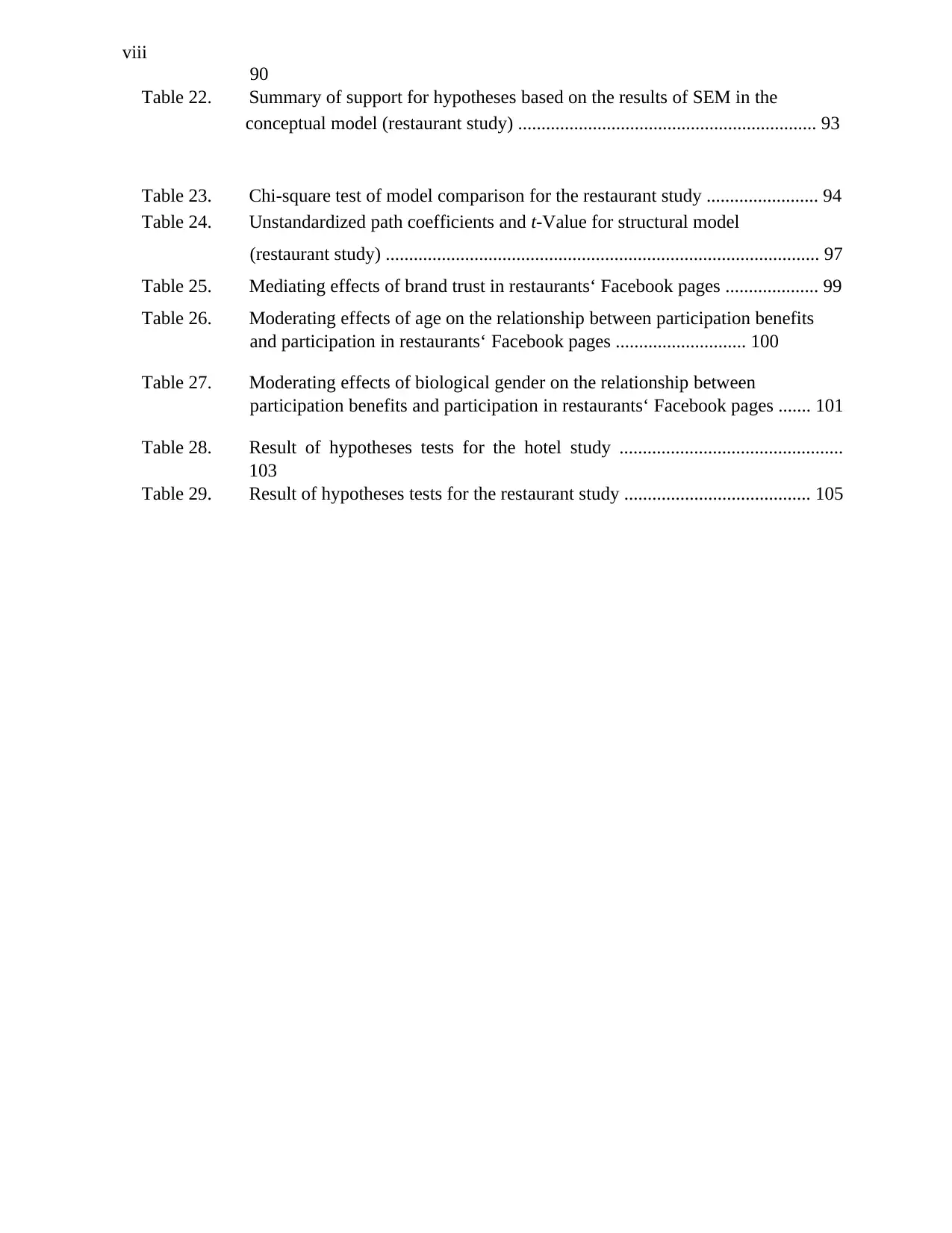
viii
90
Table 22. Summary of support for hypotheses based on the results of SEM in the
conceptual model (restaurant study) ................................................................ 93
Table 23. Chi-square test of model comparison for the restaurant study ........................ 94
Table 24. Unstandardized path coefficients and t-Value for structural model
(restaurant study) ............................................................................................. 97
Table 25. Mediating effects of brand trust in restaurants‘ Facebook pages .................... 99
Table 26. Moderating effects of age on the relationship between participation benefits
and participation in restaurants‘ Facebook pages ............................ 100
Table 27. Moderating effects of biological gender on the relationship between
participation benefits and participation in restaurants‘ Facebook pages ....... 101
Table 28. Result of hypotheses tests for the hotel study ................................................
103
Table 29. Result of hypotheses tests for the restaurant study ........................................ 105
90
Table 22. Summary of support for hypotheses based on the results of SEM in the
conceptual model (restaurant study) ................................................................ 93
Table 23. Chi-square test of model comparison for the restaurant study ........................ 94
Table 24. Unstandardized path coefficients and t-Value for structural model
(restaurant study) ............................................................................................. 97
Table 25. Mediating effects of brand trust in restaurants‘ Facebook pages .................... 99
Table 26. Moderating effects of age on the relationship between participation benefits
and participation in restaurants‘ Facebook pages ............................ 100
Table 27. Moderating effects of biological gender on the relationship between
participation benefits and participation in restaurants‘ Facebook pages ....... 101
Table 28. Result of hypotheses tests for the hotel study ................................................
103
Table 29. Result of hypotheses tests for the restaurant study ........................................ 105
Paraphrase This Document
Need a fresh take? Get an instant paraphrase of this document with our AI Paraphraser
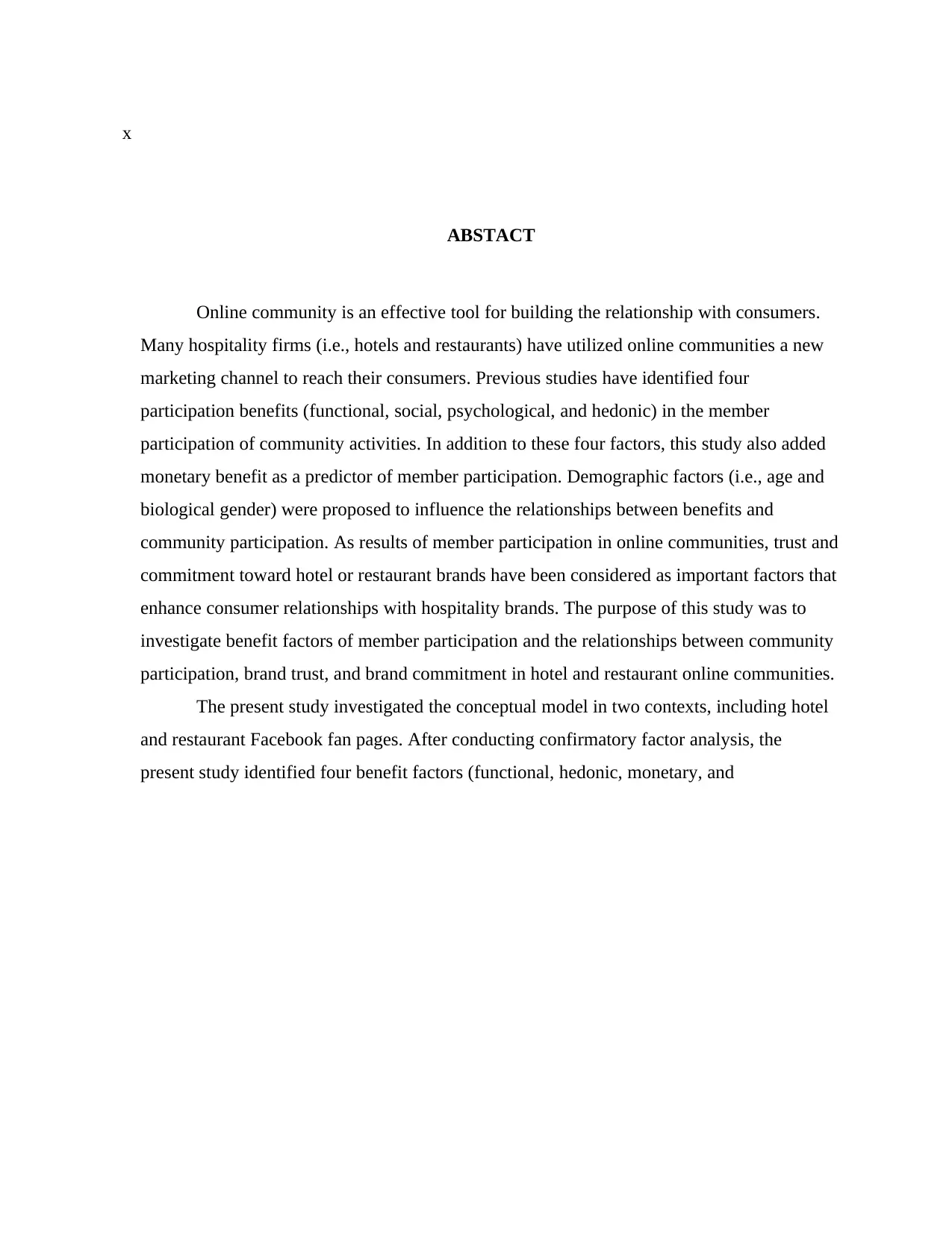
x
ABSTACT
Online community is an effective tool for building the relationship with consumers.
Many hospitality firms (i.e., hotels and restaurants) have utilized online communities a new
marketing channel to reach their consumers. Previous studies have identified four
participation benefits (functional, social, psychological, and hedonic) in the member
participation of community activities. In addition to these four factors, this study also added
monetary benefit as a predictor of member participation. Demographic factors (i.e., age and
biological gender) were proposed to influence the relationships between benefits and
community participation. As results of member participation in online communities, trust and
commitment toward hotel or restaurant brands have been considered as important factors that
enhance consumer relationships with hospitality brands. The purpose of this study was to
investigate benefit factors of member participation and the relationships between community
participation, brand trust, and brand commitment in hotel and restaurant online communities.
The present study investigated the conceptual model in two contexts, including hotel
and restaurant Facebook fan pages. After conducting confirmatory factor analysis, the
present study identified four benefit factors (functional, hedonic, monetary, and
ABSTACT
Online community is an effective tool for building the relationship with consumers.
Many hospitality firms (i.e., hotels and restaurants) have utilized online communities a new
marketing channel to reach their consumers. Previous studies have identified four
participation benefits (functional, social, psychological, and hedonic) in the member
participation of community activities. In addition to these four factors, this study also added
monetary benefit as a predictor of member participation. Demographic factors (i.e., age and
biological gender) were proposed to influence the relationships between benefits and
community participation. As results of member participation in online communities, trust and
commitment toward hotel or restaurant brands have been considered as important factors that
enhance consumer relationships with hospitality brands. The purpose of this study was to
investigate benefit factors of member participation and the relationships between community
participation, brand trust, and brand commitment in hotel and restaurant online communities.
The present study investigated the conceptual model in two contexts, including hotel
and restaurant Facebook fan pages. After conducting confirmatory factor analysis, the
present study identified four benefit factors (functional, hedonic, monetary, and
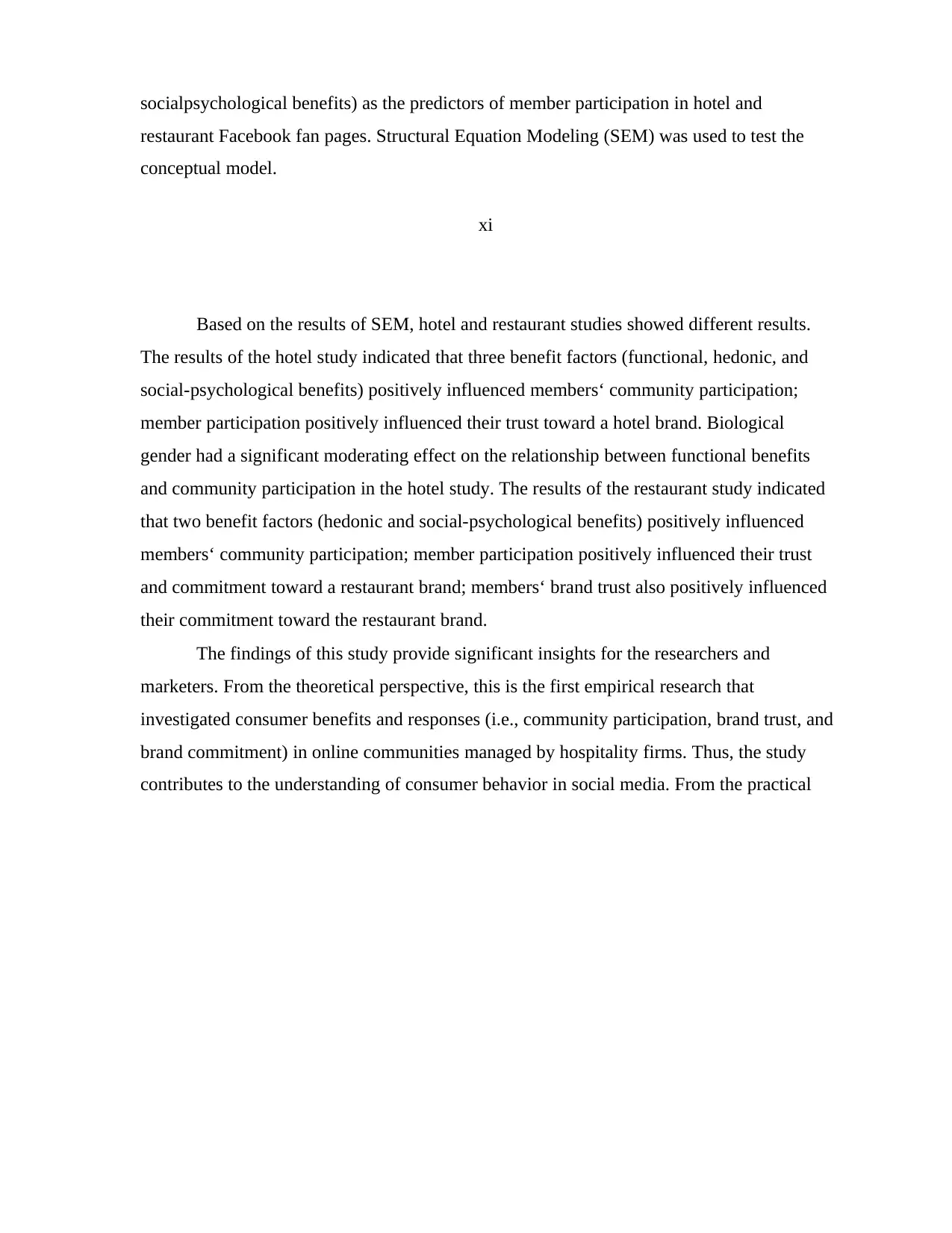
socialpsychological benefits) as the predictors of member participation in hotel and
restaurant Facebook fan pages. Structural Equation Modeling (SEM) was used to test the
conceptual model.
xi
Based on the results of SEM, hotel and restaurant studies showed different results.
The results of the hotel study indicated that three benefit factors (functional, hedonic, and
social-psychological benefits) positively influenced members‘ community participation;
member participation positively influenced their trust toward a hotel brand. Biological
gender had a significant moderating effect on the relationship between functional benefits
and community participation in the hotel study. The results of the restaurant study indicated
that two benefit factors (hedonic and social-psychological benefits) positively influenced
members‘ community participation; member participation positively influenced their trust
and commitment toward a restaurant brand; members‘ brand trust also positively influenced
their commitment toward the restaurant brand.
The findings of this study provide significant insights for the researchers and
marketers. From the theoretical perspective, this is the first empirical research that
investigated consumer benefits and responses (i.e., community participation, brand trust, and
brand commitment) in online communities managed by hospitality firms. Thus, the study
contributes to the understanding of consumer behavior in social media. From the practical
restaurant Facebook fan pages. Structural Equation Modeling (SEM) was used to test the
conceptual model.
xi
Based on the results of SEM, hotel and restaurant studies showed different results.
The results of the hotel study indicated that three benefit factors (functional, hedonic, and
social-psychological benefits) positively influenced members‘ community participation;
member participation positively influenced their trust toward a hotel brand. Biological
gender had a significant moderating effect on the relationship between functional benefits
and community participation in the hotel study. The results of the restaurant study indicated
that two benefit factors (hedonic and social-psychological benefits) positively influenced
members‘ community participation; member participation positively influenced their trust
and commitment toward a restaurant brand; members‘ brand trust also positively influenced
their commitment toward the restaurant brand.
The findings of this study provide significant insights for the researchers and
marketers. From the theoretical perspective, this is the first empirical research that
investigated consumer benefits and responses (i.e., community participation, brand trust, and
brand commitment) in online communities managed by hospitality firms. Thus, the study
contributes to the understanding of consumer behavior in social media. From the practical
⊘ This is a preview!⊘
Do you want full access?
Subscribe today to unlock all pages.

Trusted by 1+ million students worldwide

perspective, the study suggests some strategies to effectively design hotel and restaurant
Facebook fan pages, which can strengthen the relationships with current consumers and
attract potential consumers.
Facebook fan pages, which can strengthen the relationships with current consumers and
attract potential consumers.
Paraphrase This Document
Need a fresh take? Get an instant paraphrase of this document with our AI Paraphraser
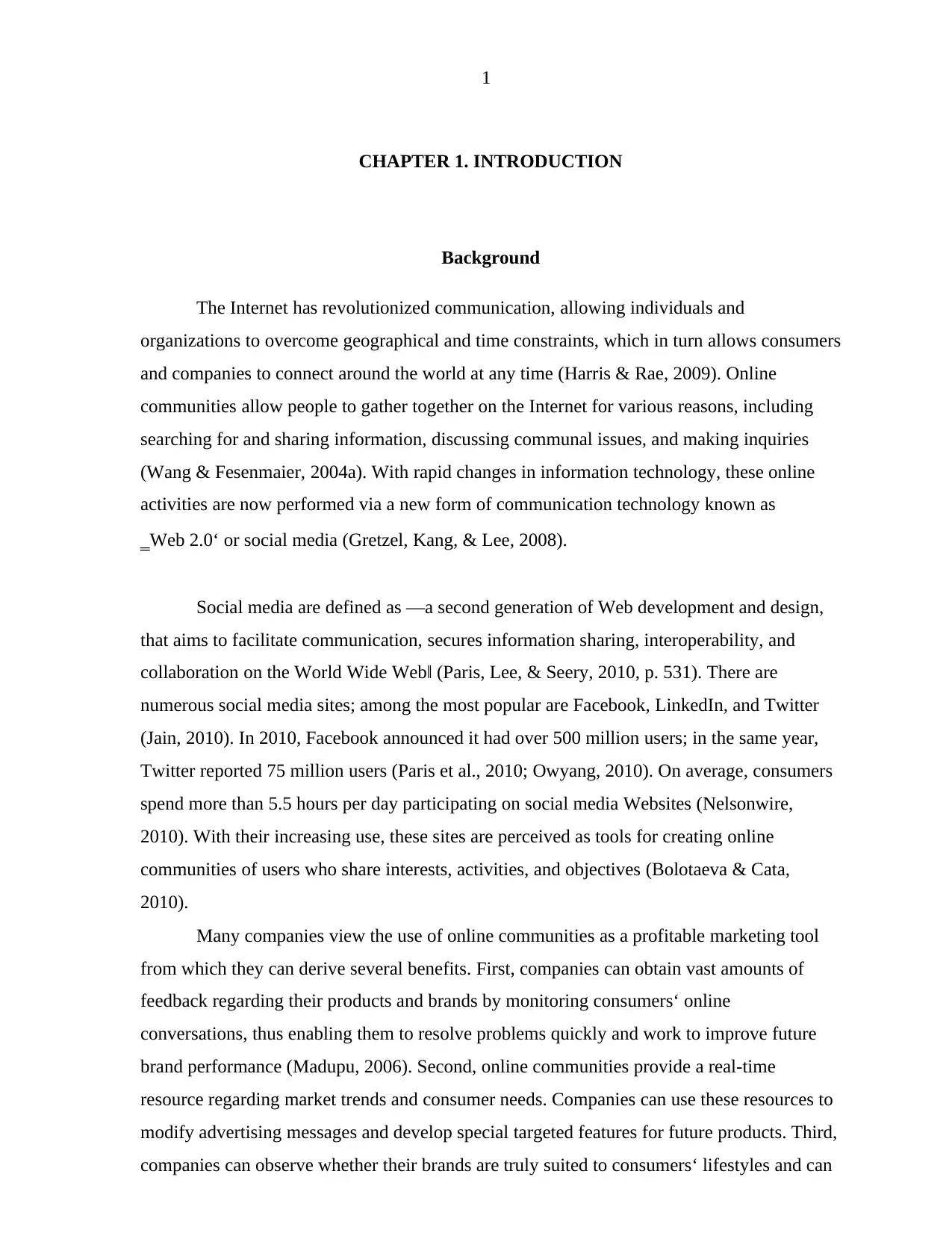
1
CHAPTER 1. INTRODUCTION
Background
The Internet has revolutionized communication, allowing individuals and
organizations to overcome geographical and time constraints, which in turn allows consumers
and companies to connect around the world at any time (Harris & Rae, 2009). Online
communities allow people to gather together on the Internet for various reasons, including
searching for and sharing information, discussing communal issues, and making inquiries
(Wang & Fesenmaier, 2004a). With rapid changes in information technology, these online
activities are now performed via a new form of communication technology known as
‗Web 2.0‘ or social media (Gretzel, Kang, & Lee, 2008).
Social media are defined as ―a second generation of Web development and design,
that aims to facilitate communication, secures information sharing, interoperability, and
collaboration on the World Wide Web‖ (Paris, Lee, & Seery, 2010, p. 531). There are
numerous social media sites; among the most popular are Facebook, LinkedIn, and Twitter
(Jain, 2010). In 2010, Facebook announced it had over 500 million users; in the same year,
Twitter reported 75 million users (Paris et al., 2010; Owyang, 2010). On average, consumers
spend more than 5.5 hours per day participating on social media Websites (Nelsonwire,
2010). With their increasing use, these sites are perceived as tools for creating online
communities of users who share interests, activities, and objectives (Bolotaeva & Cata,
2010).
Many companies view the use of online communities as a profitable marketing tool
from which they can derive several benefits. First, companies can obtain vast amounts of
feedback regarding their products and brands by monitoring consumers‘ online
conversations, thus enabling them to resolve problems quickly and work to improve future
brand performance (Madupu, 2006). Second, online communities provide a real-time
resource regarding market trends and consumer needs. Companies can use these resources to
modify advertising messages and develop special targeted features for future products. Third,
companies can observe whether their brands are truly suited to consumers‘ lifestyles and can
CHAPTER 1. INTRODUCTION
Background
The Internet has revolutionized communication, allowing individuals and
organizations to overcome geographical and time constraints, which in turn allows consumers
and companies to connect around the world at any time (Harris & Rae, 2009). Online
communities allow people to gather together on the Internet for various reasons, including
searching for and sharing information, discussing communal issues, and making inquiries
(Wang & Fesenmaier, 2004a). With rapid changes in information technology, these online
activities are now performed via a new form of communication technology known as
‗Web 2.0‘ or social media (Gretzel, Kang, & Lee, 2008).
Social media are defined as ―a second generation of Web development and design,
that aims to facilitate communication, secures information sharing, interoperability, and
collaboration on the World Wide Web‖ (Paris, Lee, & Seery, 2010, p. 531). There are
numerous social media sites; among the most popular are Facebook, LinkedIn, and Twitter
(Jain, 2010). In 2010, Facebook announced it had over 500 million users; in the same year,
Twitter reported 75 million users (Paris et al., 2010; Owyang, 2010). On average, consumers
spend more than 5.5 hours per day participating on social media Websites (Nelsonwire,
2010). With their increasing use, these sites are perceived as tools for creating online
communities of users who share interests, activities, and objectives (Bolotaeva & Cata,
2010).
Many companies view the use of online communities as a profitable marketing tool
from which they can derive several benefits. First, companies can obtain vast amounts of
feedback regarding their products and brands by monitoring consumers‘ online
conversations, thus enabling them to resolve problems quickly and work to improve future
brand performance (Madupu, 2006). Second, online communities provide a real-time
resource regarding market trends and consumer needs. Companies can use these resources to
modify advertising messages and develop special targeted features for future products. Third,
companies can observe whether their brands are truly suited to consumers‘ lifestyles and can
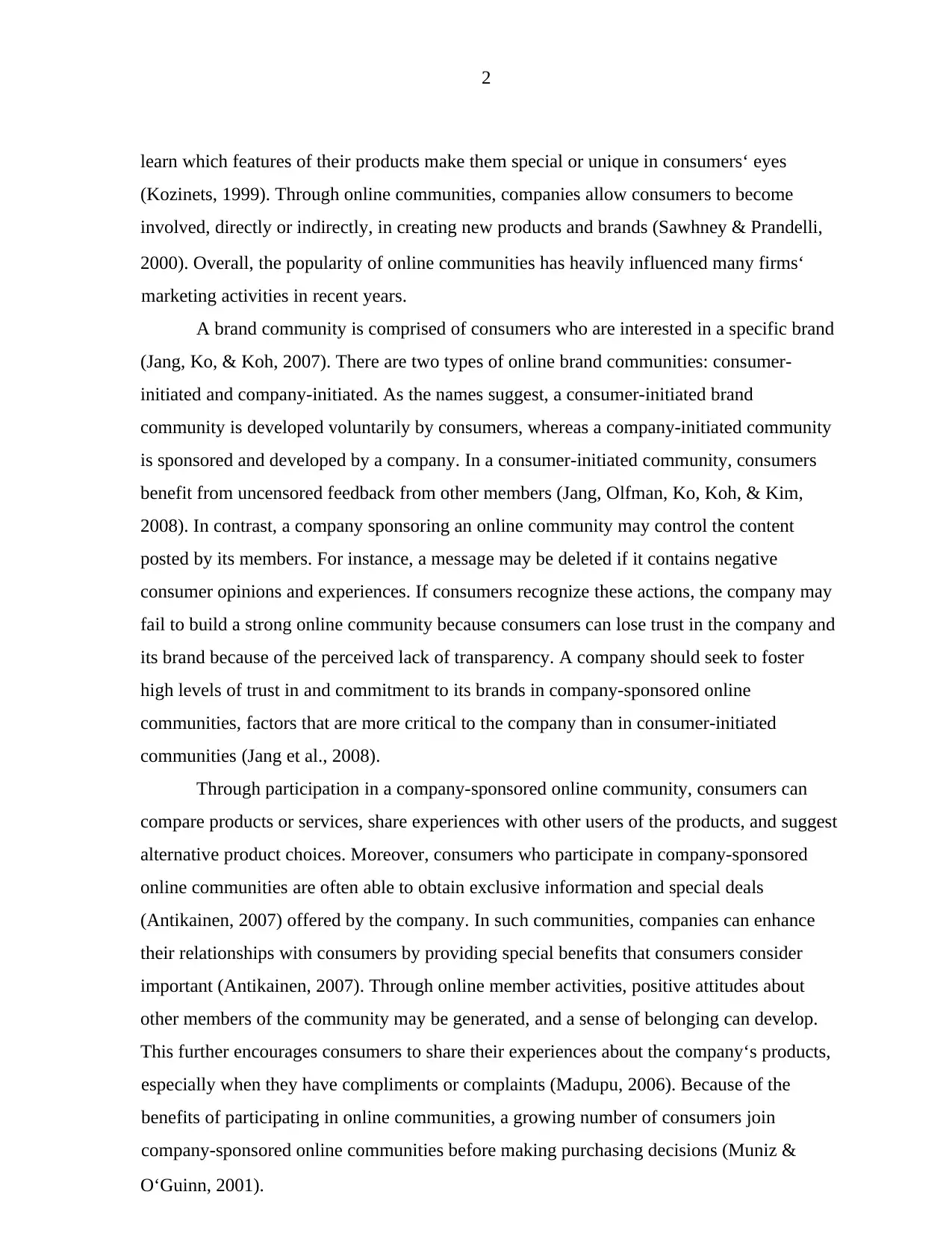
2
learn which features of their products make them special or unique in consumers‘ eyes
(Kozinets, 1999). Through online communities, companies allow consumers to become
involved, directly or indirectly, in creating new products and brands (Sawhney & Prandelli,
2000). Overall, the popularity of online communities has heavily influenced many firms‘
marketing activities in recent years.
A brand community is comprised of consumers who are interested in a specific brand
(Jang, Ko, & Koh, 2007). There are two types of online brand communities: consumer-
initiated and company-initiated. As the names suggest, a consumer-initiated brand
community is developed voluntarily by consumers, whereas a company-initiated community
is sponsored and developed by a company. In a consumer-initiated community, consumers
benefit from uncensored feedback from other members (Jang, Olfman, Ko, Koh, & Kim,
2008). In contrast, a company sponsoring an online community may control the content
posted by its members. For instance, a message may be deleted if it contains negative
consumer opinions and experiences. If consumers recognize these actions, the company may
fail to build a strong online community because consumers can lose trust in the company and
its brand because of the perceived lack of transparency. A company should seek to foster
high levels of trust in and commitment to its brands in company-sponsored online
communities, factors that are more critical to the company than in consumer-initiated
communities (Jang et al., 2008).
Through participation in a company-sponsored online community, consumers can
compare products or services, share experiences with other users of the products, and suggest
alternative product choices. Moreover, consumers who participate in company-sponsored
online communities are often able to obtain exclusive information and special deals
(Antikainen, 2007) offered by the company. In such communities, companies can enhance
their relationships with consumers by providing special benefits that consumers consider
important (Antikainen, 2007). Through online member activities, positive attitudes about
other members of the community may be generated, and a sense of belonging can develop.
This further encourages consumers to share their experiences about the company‘s products,
especially when they have compliments or complaints (Madupu, 2006). Because of the
benefits of participating in online communities, a growing number of consumers join
company-sponsored online communities before making purchasing decisions (Muniz &
O‘Guinn, 2001).
learn which features of their products make them special or unique in consumers‘ eyes
(Kozinets, 1999). Through online communities, companies allow consumers to become
involved, directly or indirectly, in creating new products and brands (Sawhney & Prandelli,
2000). Overall, the popularity of online communities has heavily influenced many firms‘
marketing activities in recent years.
A brand community is comprised of consumers who are interested in a specific brand
(Jang, Ko, & Koh, 2007). There are two types of online brand communities: consumer-
initiated and company-initiated. As the names suggest, a consumer-initiated brand
community is developed voluntarily by consumers, whereas a company-initiated community
is sponsored and developed by a company. In a consumer-initiated community, consumers
benefit from uncensored feedback from other members (Jang, Olfman, Ko, Koh, & Kim,
2008). In contrast, a company sponsoring an online community may control the content
posted by its members. For instance, a message may be deleted if it contains negative
consumer opinions and experiences. If consumers recognize these actions, the company may
fail to build a strong online community because consumers can lose trust in the company and
its brand because of the perceived lack of transparency. A company should seek to foster
high levels of trust in and commitment to its brands in company-sponsored online
communities, factors that are more critical to the company than in consumer-initiated
communities (Jang et al., 2008).
Through participation in a company-sponsored online community, consumers can
compare products or services, share experiences with other users of the products, and suggest
alternative product choices. Moreover, consumers who participate in company-sponsored
online communities are often able to obtain exclusive information and special deals
(Antikainen, 2007) offered by the company. In such communities, companies can enhance
their relationships with consumers by providing special benefits that consumers consider
important (Antikainen, 2007). Through online member activities, positive attitudes about
other members of the community may be generated, and a sense of belonging can develop.
This further encourages consumers to share their experiences about the company‘s products,
especially when they have compliments or complaints (Madupu, 2006). Because of the
benefits of participating in online communities, a growing number of consumers join
company-sponsored online communities before making purchasing decisions (Muniz &
O‘Guinn, 2001).
⊘ This is a preview!⊘
Do you want full access?
Subscribe today to unlock all pages.

Trusted by 1+ million students worldwide
1 out of 142
Your All-in-One AI-Powered Toolkit for Academic Success.
+13062052269
info@desklib.com
Available 24*7 on WhatsApp / Email
![[object Object]](/_next/static/media/star-bottom.7253800d.svg)
Unlock your academic potential
Copyright © 2020–2025 A2Z Services. All Rights Reserved. Developed and managed by ZUCOL.